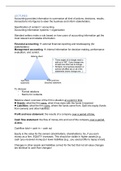Summary
Summary Financial Accounting VU IBA
- Course
- Institution
Summary containing all the relevant theory discussed during the course Accounting given in the first year of International Business Administration at the Vrije Universiteit Amsterdam. By learning this summary I personally passed the final exam.
[Show more]



